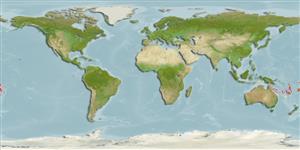Teleostei (teleosts) >
Blenniiformes (Blennies) >
Blenniidae (Combtooth blennies) > Salariinae
Etymology: Ecsenius: Greek, exenios, -os, -on = uncontrolled, immoderate.
Environment: milieu / climate zone / depth range / distribution range
Ecology
Marine; reef-associated; depth range 6 - 10 m (Ref. 5296). Tropical
Western Pacific: New Caledonia and New Hebrides (Vanuatu).
Size / Weight / Age
Maturity: Lm ? range ? - ? cm
Max length : 4.5 cm SL male/unsexed; (Ref. 5296)
Dorsal spines (total): 12; Dorsal soft rays (total): 14 - 15; Anal spines: 2; Anal soft rays: 16 - 17; Vertebrae: 33. Dorsal fin XII.14 or 15, with deep notch between spinous and segmented-ray portions. Anal fin II,16 or 17. Pectoral fin 13. Segmented caudal-fin rays 13. Vertebrae 10 + 23. Dentary incisor teeth 50-54 which includes anterior canine teeth very similar in appearance with incisors; posterior canines 1 on each side. Lateral line without vertical pairs of pores, terminating posteriorly at some point between vertical from interspace between dorsal-fin spines 10 and 11and vertical from first segmented ray. With cirrus on posterior rim of anterior nostril; absent on anterior rim. Dark spots on posterior half of body tile-like, surrounded and separated from each other only by pale, grout-like (interconnected) network (Ref. 5296).
Oviparous. Eggs are demersal and adhesive (Ref. 205), and are attached to the substrate via a filamentous, adhesive pad or pedestal (Ref. 94114). Larvae are planktonic, often found in shallow, coastal waters (Ref. 94114).
Life cycle and mating behavior
Maturities | Reproduction | Spawnings | Egg(s) | Fecundities | Larvae
Oviparous, distinct pairing (Ref. 205).
Springer, V.G., 1988. The Indo-Pacific blenniid fish genus Ecsenius. Smithson. Contrib. Zool. (465):134 p. (Ref. 5296)
IUCN Red List Status (Ref. 130435)
Threat to humans
Harmless
Human uses
Tools
Special reports
Download XML
Internet sources
Estimates based on models
Preferred temperature (Ref.
123201): 25.1 - 29.5, mean 28 °C (based on 424 cells).
Phylogenetic diversity index (Ref.
82804): PD
50 = 0.5000 [Uniqueness, from 0.5 = low to 2.0 = high].
Bayesian length-weight: a=0.00741 (0.00335 - 0.01640), b=3.02 (2.83 - 3.21), in cm total length, based on LWR estimates for this (Sub)family-body shape (Ref.
93245).
Trophic level (Ref.
69278): 2.0 ±0.00 se; based on food items.
Resilience (Ref.
120179): High, minimum population doubling time less than 15 months (Preliminary K or Fecundity.).
Fishing Vulnerability (Ref.
59153): Low vulnerability (10 of 100).
